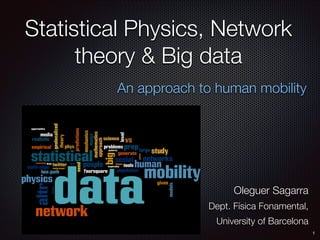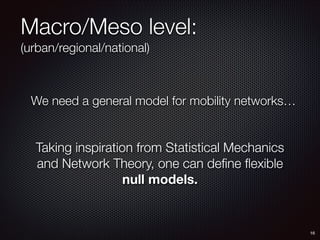Networks, Big Data and Statistical Physics: A killing combination
- 1. Statistical Physics, Network theory & Big data An approach to human mobility Oleguer Sagarra Dept. F├Łsica Fonamental, University of Barcelona 1
- 2. A killing combination... Statistical Physics & Big Data ŌĆ£New Social SciencesŌĆØ 2
- 3. Why? We want to study Human MobilityŌĆ” Mobility has deep implications in many processes.. (contagion, spread of ideas...) The development of GPS/mobile phone technologies makes gathering data cheap and possible at large scale. 3
- 4. What? (Human) Mobility is a rather complex processŌĆ” Different scales (Micro/Meso/Macro) Society is heterogeneousŌĆ” (Humans are not ŌĆ£monkeysŌĆØŌĆ” in principle!) But we are physicists! So we will try to model it anywayŌĆ” 4
- 5. But we donŌĆÖt need modellingŌĆ” ŌĆ£Computers are useless, they can only give you answersŌĆ”ŌĆØ (P. Picasso) This talk is about questions ratherŌĆ” ŌĆ£Models push the boundaries of our understanding" 5
- 7. The data... (has problems) a) How to get it? Private companies (Social Media) Citizens 7
- 8. Getting the data... Experiments Smartphones give lots of ŌĆ£sensing opportunitiesŌĆØ Citizen science aims to involve people in data collection, sharing and processing BeePath: Experiments on human mobility http://bee-path.net (Btw: Very interesting project, but donŌĆÖt have time for it today) 8
- 9. Getting the data... Social Media b) Is it biased? (Big data can also mean big errors) 9
- 10. Social media data Social media data is geolocalized, we can extract trajectories from it. But ’¼ürst, is the data representative from the population? (We want info about people, not about ŌĆ£some people that tweet a lotŌĆØ) We can compare with the censusŌĆ” Analysis must be done at user level! 10
- 11. The data... is geolocalized, and (too) big! c) Continuous vs discrete data From points to a network? (We want only the ’¼éows: From where and to where people go, ŌĆ£on averageŌĆØ) 11
- 12. The network approach Data Filtering Aggregation (grid) Network 12
- 13. Network data (We can now apply network metrics andŌĆ” data is normalized!) Sagarra, O. Master Thesis. http://upcommons.upc.edu/pfc/handle/ 2099.1/13134 13
- 14. Now we know how to deal with the data... We want to detect ŌĆ£abnormalŌĆØ patterns... What is chance, what is not? What is important, what is not? 14
- 15. Modeling as a physicistŌĆ” Take all trivial elements outŌĆ” Keep just the ŌĆ£basicŌĆØ factors in mobility ! - Distance / Cost (a.k.a. laziness) - Population density (a.k.a. opportunities) (We look for causality, not correlation) 15
- 16. Macro/Meso level: (urban/regional/national) We need a general model for mobility networksŌĆ” Taking inspiration from Statistical Mechanics and Network Theory, one can de’¼üne ’¼éexible null models. 16
- 17. We need a null model for the data... Procedure: 1. Fix some hypothesis ŌĆ£The population leaving or entering each cell is givenŌĆØ ! (quite a lot of mathsŌĆ”.)* 2. Generate predictions ŌĆ£How do the ’¼éows organize?ŌĆØ ! 3. Compare Data vs Prediction Sagarra, O. et altr. Phys. Rev. E 88, 062806 (2013) 17
- 18. Roadmap Raw data Experiments, Databases... Prediction (Product) Data treatment tools Statistical Validation Hypothesis... Modelling (We are here) Clean data Null Model predictions Data features Visualizations 18
- 19. WhatŌĆÖs the goal of all this? Understand what drives human mobility Discriminate important factors from negligible ones (population density, distance, cost...) Create tools to study data in an unbiased manner 19
- 20. osagarra@ub.edu @usagarra Thanks for your attention... 20




















